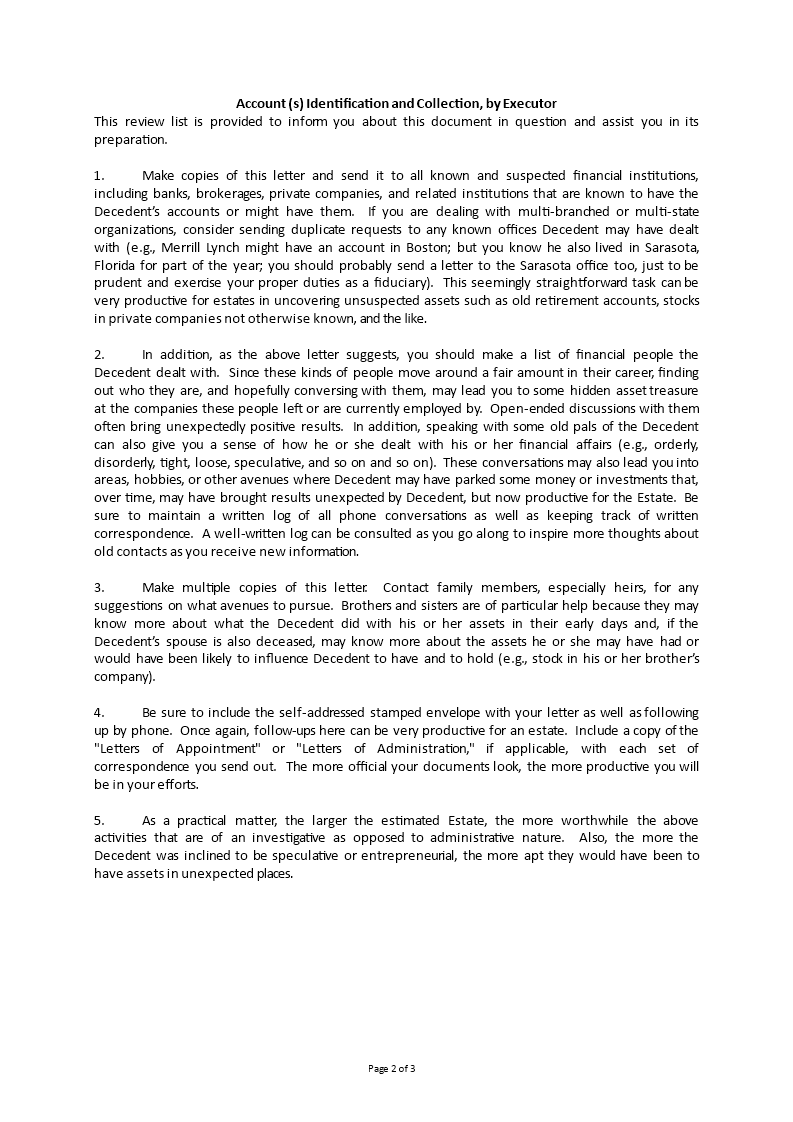Account Identification & Collection By Executor

Enregistrer, Remplir les champs vides, Imprimer, Terminer!
How to create a Real Estate Account Identification and Collection? What is the meaning of an executor account and how does it work? Download this Real Estate Account Identification & Collection by Executor template now!
Prix: USD 1.49
Téléchargez-le maintenant

Formats de fichiers premium disponibles:
.docx- Ce document a été certifié par un professionnel
- 100% personnalisable
Business Entreprise Real estate Immobilier
How to create a Real Estate Account Identification and Collection? What is the meaning of an executor account and how does it work? We provide a comprehensive template that outlines all the necessary steps for identifying and collecting an account. The template can be easily downloaded and used.
An account identification & collection by executor" typically refers to a process carried out by the executor of a deceased person's estate in order to identify, gather, and manage the financial accounts and assets that were owned by the deceased individual. This process is an essential part of administering an estate after someone passes away.
Here's a breakdown of what this process entails:
- Account Identification: The executor's first task is to identify all financial accounts and assets owned by the deceased. This includes bank accounts, investment accounts, retirement accounts, real estate, personal property, and any other assets. The executor will need to review the deceased person's records, including financial statements, will, trust documents, and any other relevant paperwork.
- Collection: Once the executor has identified the accounts and assets, they take steps to collect and secure them. This may involve contacting financial institutions, government agencies, and other entities where the deceased had accounts or assets. The executor will need to provide legal documentation, such as a death certificate and a copy of the will, to access and collect these assets.
- Valuation: The executor is responsible for determining the value of the assets in the estate. This may require appraisals for certain assets, such as real estate or valuable personal property. Valuation is crucial for estate tax purposes and for distributing assets to beneficiaries.
- Management: During the estate administration process, the executor may need to manage and maintain assets, especially if it takes some time to distribute them to beneficiaries. This could include managing investment accounts or overseeing rental properties.
- Debts and Liabilities: The executor is also responsible for identifying and addressing any outstanding debts and liabilities of the deceased. This includes paying creditors and settling any outstanding bills or obligations.
- Distribution: Once all assets have been collected, debts settled, and taxes paid, the executor distributes the remaining assets to the beneficiaries according to the instructions in the deceased person's will or trust. This distribution must be done in accordance with applicable laws and regulations.
It's important to note that the executor of an estate has a fiduciary duty to act in the best interests of the estate and its beneficiaries. This means they must carry out their responsibilities diligently, honestly, and in accordance with the law. Executors often seek legal and financial advice to ensure they fulfill their duties correctly.
Download this Real Estate Account Identification & Collection by Executor template now!
AVERTISSEMENT
Rien sur ce site ne doit être considéré comme un avis juridique et aucune relation avocat-client n'est établie.
Si vous avez des questions ou des commentaires, n'hésitez pas à les poster ci-dessous.


